Hydrogen Energy
Hydrogen Energy Industrial Park Construction Project of Baicheng City
1. Introduction to the Project
1.1 Project background
1.1.1 Product introduction
Hydrogen energy is a secondary energy source that has abundant sources, and is green, low-carbon, and widely used. It can help large-scale consumption of renewable energy, achieve large-scale peak shaving of the power grid, and store energy across seasons and regions, and accelerate the low-carbon development of industrial, construction, transportation, and other fields.
Synthetic ammonia refers to the ammonia that is directly synthesized from nitrogen and hydrogen at high temperature, high pressure, and in the presence of a catalyst, which is a basic inorganic chemical process. Synthetic ammonia serves as a carrier for storing and transporting hydrogen energy in the energy field
The project makes hydrogen production from water electrolysis and synthetic ammonia from produced hydrogen in the Hydrogen Energy Industrial Park of Taonan Economic Development Zone in Jilin Province, creates a local hydrogen energy economic ecosystem and hydrogen energy industrial chain, and promotes the development of the new energy industry.
1.1.2 Market prospect
(1) The current situation of China’s hydrogen energy industry
Over more than a decade of significant development, China’s annual hydrogen output has exceeded 10 million tons, ranking as the world’s largest hydrogen-producing country; Meanwhile, China’s output and sales of metal hydrogen storage materials have surpassed Japan, becoming the world’s largest producer and seller of hydrogen storage materials. China is ranked as the No. 1 country in terms of output of hydrogen and output and sales volume of hydrogen storage materials, which has created favorable conditions for China to develop and utilize new energy and accelerate its entry into the era of hydrogen energy economy. Driven by the continuous maturity of technologies in fields such as hydrogen production, storage, transportation, refueling, and emerging applications, the scale of China’s hydrogen energy industry has shown further growth. In 2023, output of hydrogen in China was 36.862 million tons, with year-on-year growth of 4.34%.
Table 1 Output and growth rate of hydrogen in China from 2017 to 2023
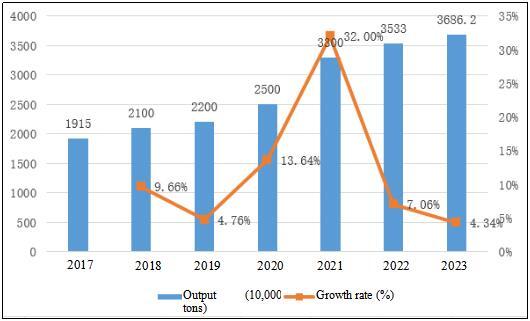
From the distribution of China’s six major regions, hydrogen is mainly produced in the Northwest China, North China, and East China, accounting for a total of 77.3%. The hydrogen output is 10.211 million tons in Northwest China, 9.252 million tons in North China, and 9.031 million tons in East China.
Table 2 Regional Structure of Hydrogen Production in China in 2023

From the perspective of hydrogen production, the amount of hydrogen production from coal reached 21.269 million tons, accounting for 57.7% of the total hydrogen sources; The amount of hydrogen production from natural gas is 8.257 million tons, accounting for 22.4%; by-product hydrogen from industrial process is 6.82 million tons, accounting for 18.5%. Hydrogen production from other technologies such as hydrogen production from water electrolysis of renewable energy power has slightly increased to 516,000 tons, accounting for 1.4%.
Table 3 Hydrogen Production Structure in China in 2023 (by Source)
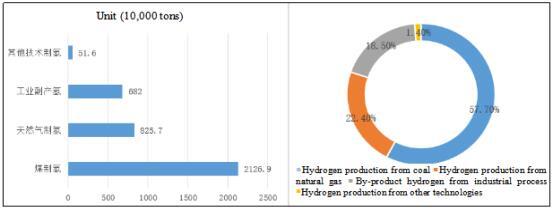
In 2023, the largest application of hydrogen consumption in China was still in the field of petroleum refining, reaching 11.45 million tons; Methanol production of methanol and synthetic ammonia grew rapidly, with a consumption of 11.179 million tons and 10.483 million tons, respectively; Consumption in other industrial fields was 5.531 million tons; The application markets in other fields such as transportation and power generation was still in the promotion stage, with hydrogen consumption accounting for only 0.1%.
Table 4 Consumption structure of hydrogen in China in 2023 (by purpose)
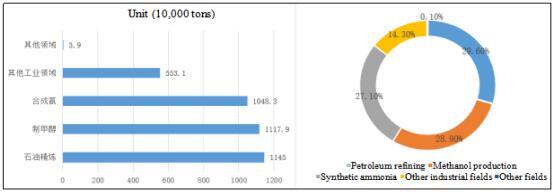
Hydrogen refueling stations are important infrastructure for hydrogen energy application, mainly consisting of links such as hydrogen production, compression, storage, refueling, and control. Currently, the hydrogen refueling stations in China generally use high-pressure hydrogen storage cylinder units and high-pressure hydrogen storage tanks as fixed hydrogen storage facilities. As of the end of 2023, China has built 474 hydrogen refueling stations, an increase of 34.66% compared to 2022, continuing to maintain No. 1 in the world.
Table 5 Number and growth rate of hydrogen fueling stations having been completed in China from 2017 to 2023
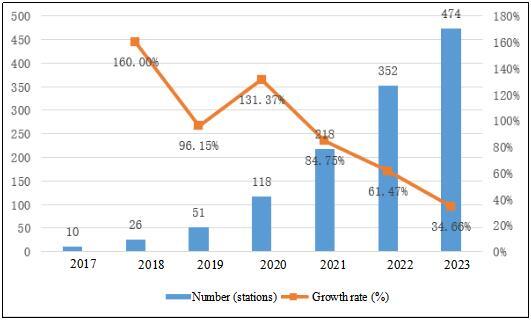
(2) Market analysis of synthetic ammonia industry
With the global emphasis on environmental protection and sustainable development, the synthetic ammonia industry will accelerate the pace of green and low-carbon transformation. By replacing traditional fossil fuels with clean energy sources (e.g., hydrogen produced from renewable energy), optimizing the production processes, and reducing carbon emissions, it will promote the industry to develop towards green and low-carbon directions.
By now, China is the world’s largest producer and consumer of synthetic ammonia, with numerous synthetic ammonia manufacturers and huge production capacity. In recent years, China’s output of synthetic ammonia has been continuously increasing. In 2022, China’s output of synthetic ammonia was 53.2101 million tons, which reached 54.8936 million tons in 2023. With the continuous increase in agricultural and industrial demand, the market size of synthetic ammonia is expected to continue to expand.
Table 6 Output and growth rate of synthetic ammonia in China from 2017 to 2023
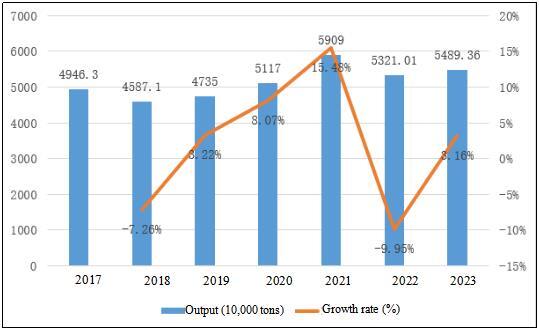
Jilin Province, as one of the 7 first-batch 10 million kilowatts wind power bases in China, has abundant wind power resources. As an enrichment region of wind energy resource, Baicheng City is located in the western plain area. Under the control of temperate continental monsoon climate, it is windy all year round and has an exploitable installed capacity of 22.8 million kilowatts, which is comparable to the installed capacity of China’s Three Gorges Hydropower Station, with quite astonishing development potential.
As one of the first-batch national 10 million kilowatts wind power bases, the only local wind power consumption demonstration zone in China, a national new energy demonstration city, and a national leading base for PV power generation application, Baicheng City is the main force in the construction of Jilin’s “Onshore Wind-light Three Gorges” project. The exploitable area of wind energy in Baicheng exceeds 5,000 square kilometers, and the exploitable area of PV exceeds 3,000 square kilometers. By now, Baicheng City has built 111 wind and PV power generation projects with a total installed capacity of 5.8 million kilowatts, accounting for 63% of the total throughout the province; there are 23 wind and PV power generation projects under construction, with a total installed capacity of 3.6 million kilowatts. By the end of the “14th Five-year Plan” period, the total installed capacity of clean energy have reached 30 million kilowatts, including 20 million kilowatts of wind power and 10 million kilowatts of PV power.
The wind energy in Taonan City is characterized by stable wind speed, low extreme maximum wind speed, high air density, and large exploitable area; Taonan City has abundant sunshine resources, with an average annual sunshine of about 2,900 hours. With the continuous increase in the installed capacity of PV and wind power generation, the proportion of new energy power generation is constantly growing. The hydrogen production from water electrolysis and related industries will benefit from the decrease in new energy electricity price, gaining better development opportunities. The project aims to tap into local wind power resources, construct hydrogen energy projects, and make hydrogen production from water electrolysis and synthetic ammonia, with promising market prospects.
1.1.3 Technical analysis
The project adopts modern production technology and automated production lines, with mature production processes and technologies, and has the conditions for large-scale production.
(1) Hydrogen production from water electrolysis process
The core of the hydrogen production technology used in this project is hydrogen production from water electrolysis. The key core technology for hydrogen production from renewable energy is efficient hydrogen production from water electrolysis technology. Hydrogen production from water electrolysis refers to the process of separating water molecules into hydrogen and oxygen at the anode and cathode poles, respectively through electrochemical processes under the action of direct current.
(2) Technical process of synthetic ammonia
Preparation of raw materials: The main raw materials of synthetic ammonia are hydrogen and nitrogen. Hydrogen usually comes from hydrogen production from water electrolysis, while nitrogen comes from air.
Purification: Before synthesizing ammonia, it is necessary to purify hydrogen and nitrogen to ensure the efficiency of the reaction and product quality. The purification process includes steps such as removing impurities, drying, and dust removal, etc.
Compression: Purified hydrogen and nitrogen need to be compressed to increase their pressure and provide necessary conditions for subsequent reactions.
Heating: Before the compressed gas is sent into the reactor, it needs to be heated to increase its temperature and provide necessary energy for the reaction.
Catalytic reaction: The heated hydrogen and nitrogen are sent into the reactor, and under the action of the catalyst, they undergo catalytic oxidation reaction to generate ammonia gas.
Cooling and separation: The ammonia generated from the reaction needs to be cooled and then separated from the unreacted gas to obtain pure ammonia.
1.1.4 Advantageous conditions of project construction
(1) Policy advantages
In March 2022, the NDRC and the National Energy Administration (NEA) jointly released the Medium and Long-term Plan for Hydrogen Energy Industry Development (2021-2035), which proposed different development goals at different stages: by 2025, the core technology and manufacturing process will have been basically mastered, the number of fuel cell vehicles will have been about 50,000, a number of hydrogen refueling stations will have been deployed and constructed, the hydrogen production from renewable energy will have reached 100,000 to 200,000 tons/year, and the carbon dioxide emissions will have been reduced by 1 to 2 million tons/year; By 2030, a relatively complete hydrogen energy industry technology innovation system, clean energy hydrogen production and supply system will have been formed, which will effectively support the achievement of carbon peaking goal; By 2035, a diversified hydrogen energy application ecosystem will have been established, and the proportion of renewable energy hydrogen production in terminal energy consumption will have been significantly increased.
In May 2024, the National Development and Reform Commission, the Ministry of Industry and Information Technology, the Ministry of Ecology and Environment, the State Administration for Market Regulation, and the National Energy Administration formulated the Special Action Plan for Energy Conservation and Carbon Reduction in the Synthetic Ammonia Industry, proposing to have increased the proportion of production capacity above the energy efficiency benchmark level in the synthetic ammonia industry to 30% by the end of 2025, and complete technological transformation or phase-out of production capacity below the energy efficiency benchmark level. From 2024 to 2025, by implementing energy conservation and carbon reduction reforms in the synthetic ammonia industry and the upgrading of energy-consuming equipment, conserve approximately 5 million tons of standard coal and reduce approximately 13 million tons of carbon dioxide. By the end of 2030, the proportion of production capacity above the energy efficiency benchmark level in the synthetic ammonia industry will have further increased, the energy resource utilization efficiency will have reached the international advanced level, the proportion of green electricity and green hydrogen consumption in the production process will have significantly increased, and the green and low-carbon development of the synthetic ammonia industry will have achieved significant results.
In August 2024, the State Council’s Opinion on Accelerating the Comprehensive Green Transition in Social and Economic Development proposed to vigorously develop non-fossil energy, develop new energy such as biomass energy, geothermal energy, and ocean energy according to local conditions, and promote the development of the entire chain of “production, storage, transportation, and utilization” of hydrogen energy. Improve the infrastructure network of charging (converter) stations, hydrogen (methanol) refueling stations, and shore power, etc., and accelerate the construction of urban intelligent transportation management system.
The 14th Five-Year Plan for Industrial Development in Jilin Province clearly stated that we should focus on developing wind power hosts, generators, blades, PV cells, and modules. We should promote the development of hydrogen energy equipment and hydrogen fuel cells around the entire industrial chain of hydrogen “production, storage, transportation, refueling and utilization”. Support the RD of intelligent heat exchange units and new high-efficiency energy-saving heat exchangers. Accelerate the development of environment-friendly equipment such as air pollution control, water pollution control, and solid waste treatment. Cultivate new energy system solution suppliers, and establish RD and manufacturing bases of new energy equipment.
In November 2022, Jilin Province released the Implementation Plan for the “Hydrogen-powered Jilin” Action, proposing that by 2025, the scale of the hydrogen energy industry in the province will have achieved leapfrog growth, hydrogen energy projects will have been orderly promoted, supporting infrastructure will have been initially improved, breakthrough will have been made in key core technologies of the hydrogen energy industry, and the layout of the industrial chain will have been basically formed. By 2030, the production capacity of hydrogen production from renewable energy will have reached 300,000 to 400,000 tons/year, and the production capacity of green synthetic ammonia, green methanol, green refining, and hydrogen metallurgy will have reached 2 million tons per year. Total 70 hydrogen refueling stations will have been built, and the operation scale of hydrogen fuel cell vehicles will have reached 7,000 units; the output value of the hydrogen energy industry will have reached a scale of 30 billion yuan. By 2035, the output value of the hydrogen energy industry will have reached a scale of 100 billion yuan.
(2) Resource advantages
Taonan is home to abundant wind power and solar energy resources, and has become the earliest region in Jilin Province to develop wind and PV power. The wind energy in Taonan City is characterized by high wind shear, stable wind speed, low extreme maximum wind speed, high air density, and large exploitable area, etc.
(3) Industrial advantages
The installed capacity of wind power in Taonan City can reach 22 million kilowatts, but only 3.335 million kilowatts are currently installed. Solar energy has great potential for development, and abundant sunshine resources, with an average annual sunshine of about 2,900 hours. Taonan City currently has new energy enterprises such as Shanghai Electric and Yaojing, and achieves a zero-emission, zero-pollution, and sustainable hydrogen energy industrial chain from development to utilization.
(4) Location advantages
Taonan has obvious location advantages, is located in the center of the border between the three northeastern provinces (Heilongjiang, Jilin and Liaoning) and eastern Inner Mongolia, with convenient transportation conditions. There are Beijing-Qiqihar Railway, and Hulan-Hailun Railway, as well as National Highway 111 and Changchun-Baicheng Expressway passing through the area. It is possible to enter Beijing from the south and directly reach Shenyang and Dalian; It can directly reach Qiqihar, Hailar and other places in the north. The highway is centered around the urban area and connects various towns in a radial pattern, with a total mileage of 861.04 kilometers. There are national trunk highways and Changchun-Baicheng West Provincial Highway passing through the territory.
(5) Talent advantages
There are Academy of Agricultural Sciences, Academy of Forestry Sciences, Agricultural Machinery Research Institute, Animal Husbandry Research Institute, Scientific Research Institute and other scientific research institutes in Baicheng City. There are 40,873 professional and technical personnel, including 6,898 with senior professional titles, 18,409 with intermediate professional titles, and 15,566 with junior professional titles. Baicheng Academy of Agricultural Sciences is the only comprehensive agricultural research institution in the semi-arid special ecological zone of western Jilin Province. It is the forefront and main research group for agricultural technology innovation and promotion in western Jilin Province. Baicheng City provides a large batch of senior technical personnel for the society every year, with nearly 10,000 practical technical talents graduating and entering the society.
1.2 Contents and scale of project construction
The project plans to cover an area of 50,000 square meters, with a total construction area of 40,000 square meters. It plans to construct the production equipment area, storage and transportation facilities area, administrative office area, auxiliary production facilities and public works area. It plans to purchase hydrogen production from water electrolysis equipment, ammonia synthesis from produced hydrogen equipment, hydrogen and ammonia storage devices, and air separation equipment, etc.
1.3 Total investment of the project and capital raising
1.3.1 Total investment of the project
The total investment of the project is 300 million yuan, including the construction investment of 250 million yuan and current funds of 50 million yuan.
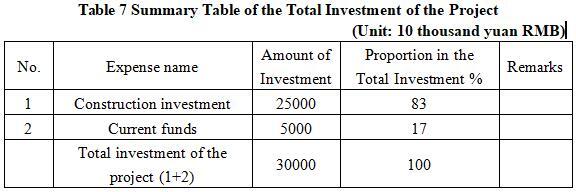
1.3.2 Capital raising
Raised by the enterprise itself.
1.4 Financial analysis and social evaluation
1.4.1 Main financial indexes
After the project reaches the production capacity, its annual sales revenue will be 210 million yuan, its profit will be 100 million yuan, its investment payback period will be 5.0 years (after the tax, including the construction period of 2 years) and its return on investment will be 33.3%.
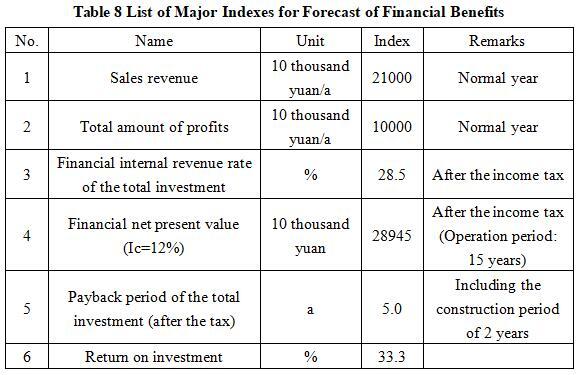
Note: “10 thousand yuan” in the table is in RMB
1.4.2 Social evaluation
This project utilizes wind and solar power generation, combined with hydrogen production from water electrolysis, and then combined with downstream synthetic ammonia chemical production, to create a green energy and zero carbon industrial system structure and production mode, and promote the green development of regional industries. The construction and implementation of this project are in line with the overall strategy of the state for developing renewable energy such as wind energy, solar energy, and new energy hydrogen. It transforms the local resource advantages into economic advantages, promotes the upgrading of industrial structure, and drives the comprehensive development of the local economy, having significant social and economic benefits.
1.5 Cooperative way
Sole proprietorship, and cooperation.
1.6 What to be invested by the foreign party
Funds, equipment and technology.
1.7 Construction site of the project
Jilin Taonan Economic Development Zone.
1.8 Progress of the project
The project proposal has been prepared.
2. Introduction to the Partner
2.1 Basic information
Name: Jilin Taonan Economic Development Zone Management Committee
Address: No. 1 Tiedong, Taonan City, Jilin Province
2.2 Overview
In December 2005, with the approval of the Development Zone Management Office of Jilin People’s Government, Taonan Economic Development Zone (Industrial Concentration Zone) was established. In February 2021, with the approval of the Jilin People’s Government, it was promoted to be a provincial-level development zone and was named Jilin Taonan Economic Development Zone. It has a planned area of 24 square kilometers, with a starting area of 6 square kilometers.
For many years, Taonan Economic Development Zone has been adhering to the development principles of “overall planning, step-by-step implementation, highlighting characteristics, industrial support, rolling development, and virtuous cycle”, closely focusing on the “1351” development goal, based on the location advantages of the commercial and economic radiation of Taonan Economic Development Zone, the agricultural resource advantages of Taonan City, and the industrial foundation advantages of Baicheng City. It has been insisting on the high-end positioning of industry-city integration, continuously constructing and improving a modern service system, and taking new energy equipment manufacturing, food and agricultural product and by product processing, and medicine and health as the leading industries. In 2022, according to the direction of industrial development, the planning layout and “three zones and three lines” was adjusted in a timely manner, and the “one center and five parks” was adjusted to “one center and seven parks”, to enhance the absorption and carrying capacity of the industries, guarantee entry of the industries into the parks and the rational utilization of the development space.
In the 2021 comprehensive development level assessment ranking, Taonan Economic Development Zone ranked 28th among the 72 provincial-level comprehensive processing development zones in the province, and ranked first among the 7 provincial-level comprehensive processing development zones in Baicheng City. At the end of 2022, there was 96 enterprises registered in or under the management of the development zone, including 28 enterprises above designated size, 4 enterprises above norm, and 1 high-tech enterprise. Gradually, a development pattern has been formed with clean energy, “dual carbon” green equipment manufacturing, medicine and health, modern agriculture, and deep processing of food and other industries as the pillar industries.
2.3 Contact method
2.3.1 Contact method of cooperator
Contact unit: Jilin Taonan Economic Development Zone Management Committee
Contact person: Gao Xuezhong
Tel: +86-436-6262011
+86-15567967499
E-mail: tnjhj2010@163.com
2.3.2 Contact method of the city (prefecture) where the project is located
Contact Unit: Baicheng Municipal Bureau of Commerce
Contact Person: Xu Zengchun
Tel: +86-436-3203010
+86-13894682986
E-mail: bcjhj07@126.com


